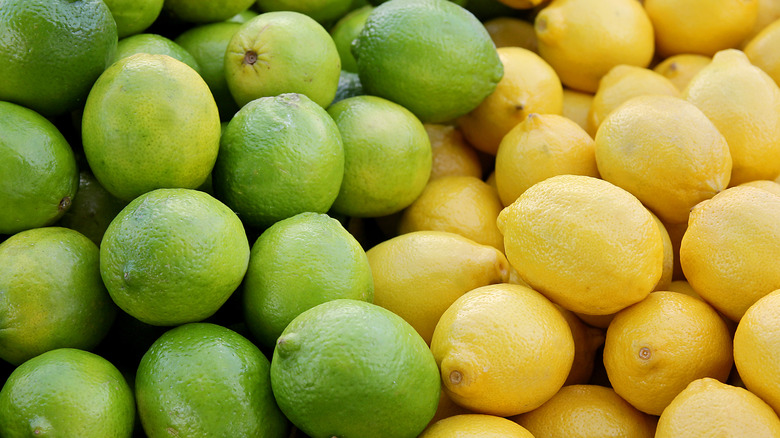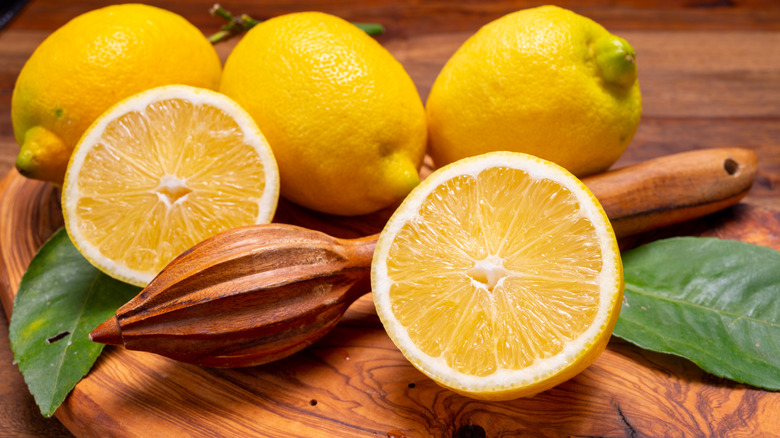When Are Lemon And Lime Juice Actually Interchangeable?
Lemon and lime juice are both invaluable for adding bright, zesty, citrusy flavors to a variety of dishes. A squeeze can bring a light zinginess and balanced flavors to everything from salad dressings to cocktails and cakes. However, if a recipe specifically calls for lemons or limes and you only have one of these citrus fruits, can you just swap them?
The simple answer is sometimes, but not always, as the results will depend on the dish. While you might not instinctively reach for lemon juice for your margarita, the swap can work surprisingly well in cocktails. In baking, switching lime for lemon can alter the flavor, but it could still yield a delicious result if you enjoy the fruit's distinctive tart taste in cakes and puddings.
Domestic goddess Nigella Lawson advises "letting your taste buds act as a guide" when swapping lemon juice for lime (or vice versa) in a recipe. While there are similarities between the two citrus fruits, notable differences mean lemons and limes are not always interchangeable, from the flavor and level of acidity or sweetness to the volume of juice they contain. However, for many dishes, especially drinks and desserts, the swap can work perfectly well, although the recipe may sometimes need a little modification.
Lemons and limes both add tartness and acidity
When baking, lemon and lime juice can often be used interchangeably in recipes, especially if the purpose of the juice is mainly to add a little freshness or tang. However, if lemon or lime is the predominant flavor of the dessert, the results won't be the same. For instance, if you're aiming to make the freshest lemon pound cake of your life, or perhaps a zesty key lime pie, the switch would make a substantial difference.
In cocktails, the juices of lemons and limes can often be swapped with each other in equal amounts. Although the final flavor may vary according to the drink, both will add tartness, acidity, and a balance of flavor. And, while it might seem unusual, you could even try a lemon margarita instead of the usual lime for a citrusy twist on the classic.
Besides taste, it's also important to consider that the maximum amount of juice you can extract from a lemon (about two tablespoons) differs from that in a lime (around one tablespoon). Therefore, if a recipe calls for the juice of one fruit and you're substituting it with the other, you may need to adjust accordingly.
Pay attention to complementary flavors
In some savory recipes, such as when preserving or canning foods, lemon and lime juice can be used interchangeably due to their similar pH levels. In salad dressings, as well as in savory and sweet sauces, lemon and lime juice both add brightness and freshness, so they can often be switched for each other.
However, it's also important to consider the nature and origin of the dish in question, and the other complementary flavors within it, when cooking with citrus. While zingy limes are often used in Mexican or Latin cuisine, for example, European dishes tend to call for aromatic lemon juice, so switching could drastically alter the complex blend of flavors.
Ultimately, the best way to assess how well the citrus swap works is to add a small amount at a time to a dish or drink and taste it to judge the balance and overall flavor. As is often the case with cooking, a lot of satisfaction comes down to personal preference. While lemons and limes may be closely related, their contributions to cooking can differ significantly. But trying a switch may just lead to a tang-tastic new take on a favorite recipe.



